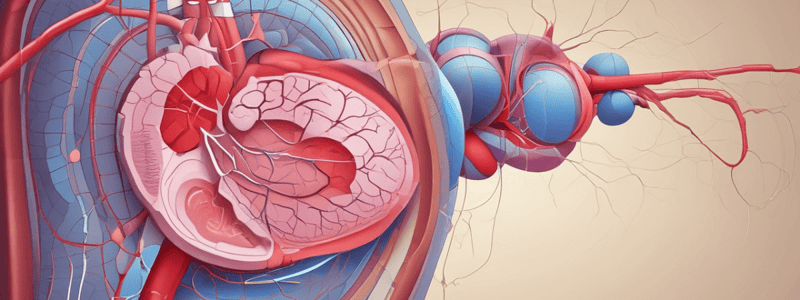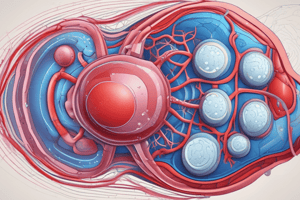Podcast
Questions and Answers
What is the number of amino acids in Angiotensiongen?
What is the number of amino acids in Angiotensiongen?
- 453 (correct)
- 10
- 20
- 8
Which receptor is stimulated by Angiotensin II to cause vasoconstriction?
Which receptor is stimulated by Angiotensin II to cause vasoconstriction?
- ACP
- ADH
- AT2
- AT1 (correct)
What is the effect of Angiotensin II on water reabsorption in the collecting duct?
What is the effect of Angiotensin II on water reabsorption in the collecting duct?
- Increased water reabsorption (correct)
- No effect on water reabsorption
- Increased water excretion
- Decreased water reabsorption
Which of the following is NOT a true statement about Renin?
Which of the following is NOT a true statement about Renin?
What is the effect of Aldosterone on potassium excretion?
What is the effect of Aldosterone on potassium excretion?
Which of the following is a characteristic of ACE inhibitors?
Which of the following is a characteristic of ACE inhibitors?
What is the function of Angiotensin-Converting Enzyme (ACE)?
What is the function of Angiotensin-Converting Enzyme (ACE)?
Which of the following is NOT a true statement about Aldosterone?
Which of the following is NOT a true statement about Aldosterone?
What is the effect of Angiotensin II on blood pressure?
What is the effect of Angiotensin II on blood pressure?
Flashcards are hidden until you start studying
Study Notes
Angiotensin II Pathway
- Angiotensin II is produced through the Chymase pathway, which involves the precursor Angiotensinogen (453 a.a.).
- Angiotensinogen is converted to Angiotensin II by the enzyme Renin (10 a.a.).
- Angiotensin II acts on the kidney through the AT1 receptor.
Effects of Angiotensin II
- Angiotensin II causes vasoconstriction, leading to increased blood pressure.
- Angiotensin II stimulates aldosterone production in the adrenal cortex, leading to increased water reabsorption in the collecting duct.
- Increased water reabsorption results in increased extracellular fluid (ECF) volume.
- Angiotensin II also increases Na+/H2O uptake and K+ excretion in the kidneys.
ACE Inhibitors and ARBs
- ACE inhibitors, such as Enalapril and Captopril, block the conversion of Angiotensin I to Angiotensin II, leading to decreased blood pressure.
- ACE inhibitors can cause coughing as a side effect due to the accumulation of bradykinin.
- ARBs, such as Losartan and Valsartan, block the action of Angiotensin II on the AT1 receptor.
- Direct renin inhibitors, such as Aliskiren, block the production of Angiotensin II by inhibiting the action of Renin.
- Aldosterone antagonists, such as Eplerenone, block the action of aldosterone on the kidneys.
Renin and Angiotensinogen
- Renin is produced by the kidneys in response to decreased blood pressure.
- Angiotensinogen is produced by the liver and released into the bloodstream.
- Renin converts Angiotensinogen to Angiotensin I, which is then converted to Angiotensin II.
True or False Quiz Answers
- True: Angiotensin II stimulates ADH secretion in the adrenal cortex to cause increased water reabsorption in the collecting duct.
- True: Renin secretion from the kidney occurs in response to decreased blood pressure.
- False: Activation of AT1 receptors elicits vasodilation.
- False: The kidney releases angiotensinogen into the blood.
- False: Aldosterone is produced in the kidney.
- True: Angiotensin II stimulates aldosterone in the adrenal cortex to cause increased water reabsorption in the collecting duct.
- True: Renin secretion from the kidney occurs in response to decreased blood pressure.
- True: ACE is expressed in the liver.
- False: Kidney releases angiotensinogen into the blood.
- False: Aldosterone is produced in the kidney.
Studying That Suits You
Use AI to generate personalized quizzes and flashcards to suit your learning preferences.




